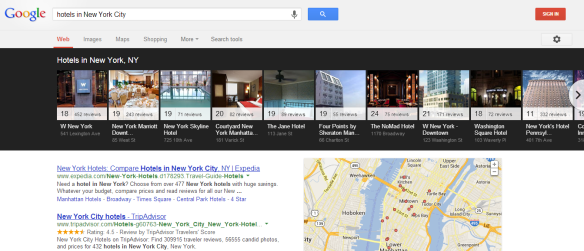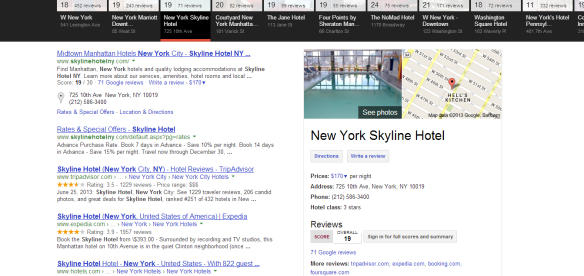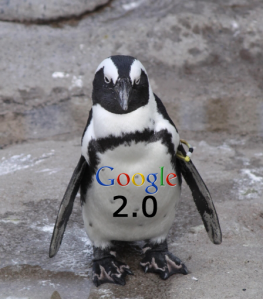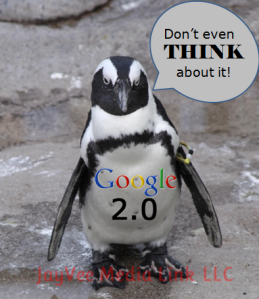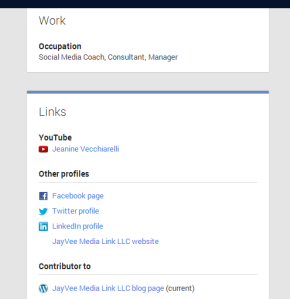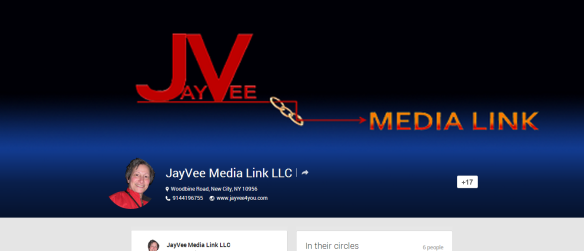May 7, 2012
by Jeanine Vecchiarelli return to
JayVee Media Link LLC
 Google has changed its algorithms yet again as it strives to maintain its spot at the top of the search engine heap. It has brought us the Chrome browser, Google Plus social profiles, Gmail, Google Maps, Adwords, Analytics, Google Documents, Alerts. It has given us the Android phone along with tons of mostly free apps in Google Play. It owns You Tube; it just rolled out Drive, a cloud based service. These days, is it even possible to go ANYWHERE on the web and NOT use a service that has some connection to Google?
Google has changed its algorithms yet again as it strives to maintain its spot at the top of the search engine heap. It has brought us the Chrome browser, Google Plus social profiles, Gmail, Google Maps, Adwords, Analytics, Google Documents, Alerts. It has given us the Android phone along with tons of mostly free apps in Google Play. It owns You Tube; it just rolled out Drive, a cloud based service. These days, is it even possible to go ANYWHERE on the web and NOT use a service that has some connection to Google?
Back in the day, there was an entity through which ALL telecommunication was routed. Mind you, there wasn’t much beside literally telephone communication. The entity was known as Ma Bell, and it was unquestionably a monopolistic enterprise. It owned all the equipment and all the lines, right down to the phones in our homes. It was the only provider of telecommunication service. It charged what it charged, and the only recourse we had if we were unhappy was to not have phone service.
In the 1970s, an Antitrust lawsuit was filed against Ma Bell. Years later, when the dust finally settled, the big ol’ girl was broken up into several smaller companies. A number of them have since merged back together, but Ma Bell itself is no more. With the introduction of competition came an amazing set of phenomena. Suddenly, prices were negotiable. We could buy our own equipment. Phones became more stylish, more functional, and even wireless. We saw the dawn of the digital age, and of fiber optic. Competition also brought us our lifelines: our mobile phones. And of course, we were able to hook in to the World Wide Web.
The question that arises from my stroll down memory lane is, has the time come to assess Google, and evaluate whether it is becoming our next big Ma Bell-like monopoly? We all have probably heard the term applied to Google these days, along with its legal counterpart, Antitrust.

The argument can be made that Google is not actively trying to drive its competitors out of existence. If it was, then it would make sense to apply the moniker “monopoly” to it. As a business, it has every right to preserve its top rating. Strategies to do this include striving to innovate and expand in order to offer its users the best possible online experience. Its competitors are doing the same thing; as of now, though, they are not doing it as successfully or with the same foresight as the Google folks. So is that Google’s fault?
I have my issues with Google. Most concern privacy rights. Yet even so, I have to concede that Google would not be able to offer the broad, interrelated services it does, let alone offer them mostly for free, without more access to my private data than I am comfortable sharing. On one level, it is my choice to continue using Google and its related services. But on another, can I really have the benefit of access to all the features I enjoy via other services? You Tube is a very significant platform in the field of social media marketing; how can I maintain a presence on it without being connected to Google if the platform is OWNED by that company? And if I COULD sever my ties to Google, wouldn’t I still have the same privacy issues with its competitors, unless I would be willing to pay who knows how much money to use the services anonymously? Again, that isn’t even feasible for some of the features.
In the end, I do choose to use Google and all of its wonderful offerings. I fully support its quest to remain the best, so long as it doesn’t look to shut down its competitors. And I do what I can to safeguard as much of my privacy as possible.
What are YOUR views about Google? Do you think it’s a monopoly? Should an Antitrust lawsuit be pursued against it? What alternatives do you think we have? Please share your perspective by leaving your thoughts in the comments section below.

Beware the Penguin!
 The answer to this shift is to adjust our content to reflect Google’s emphasis on quality creation. Google wants us to build links, but via the natural route: the higher the quality of the value we impart, the more our readers will want to visit our sites. So we need to concentrate more on readability, word flow and informational value, and less on keyword stuffing and rich anchor text links. We can also boost our website traffic via other Google approved methods such as our Google Plus and other social media profiles, and registering our businesses with location services.
The answer to this shift is to adjust our content to reflect Google’s emphasis on quality creation. Google wants us to build links, but via the natural route: the higher the quality of the value we impart, the more our readers will want to visit our sites. So we need to concentrate more on readability, word flow and informational value, and less on keyword stuffing and rich anchor text links. We can also boost our website traffic via other Google approved methods such as our Google Plus and other social media profiles, and registering our businesses with location services.




